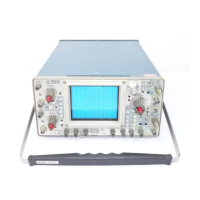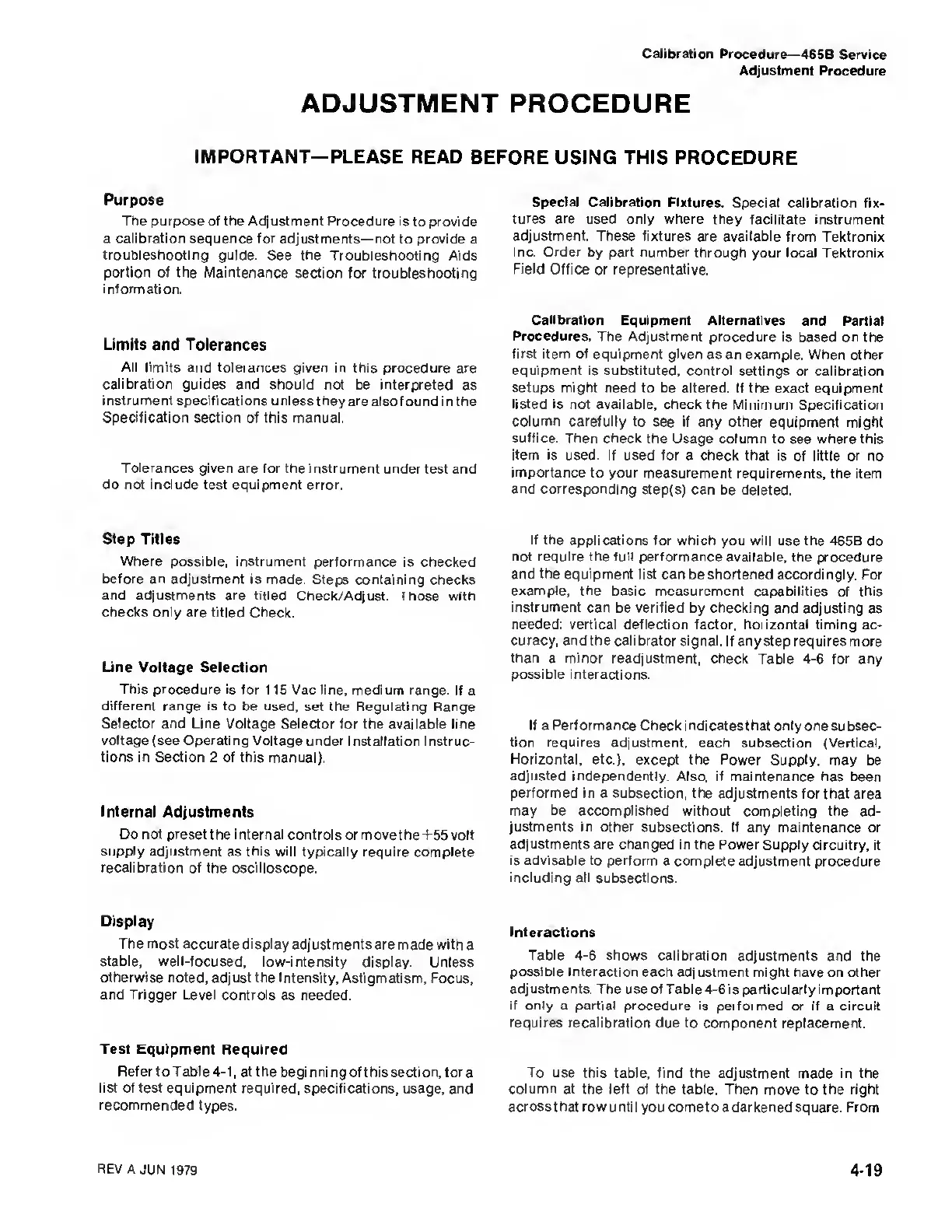Calibration
Procedure—
465B Service
Adjustment Procedure
ADJUSTMENT
PROCEDURE
IMPORTANT—
PLEASE READ BEFORE USING
THIS PROCEDURE
Purpose
The purpose of the Adjustment
Procedure is to provide
a
calibration
sequence for adjustments—not to provide
a
troubleshooting
guide. See the Troubleshooting Aids
portion of the Maintenance
section for troubleshooting
information.
Limits and Tolerances
All
limits and tolerances given in this
procedure
are
calibration guides and should
not be interpreted as
instrument specifications
unless they are also found in the
Specification section of this
manual.
Tolerances given are
for the instrument under test and
do not include
test equipment error.
Step Titles
Where possible,
instrument performance
is
checked
before an adjustment is made.
Steps containing checks
and adjustments are titled Check/Adjust,
fhose
with
checks only are
titled Check.
Line Voltage Selection
This procedure is for 1
15
Vac
line, medium range. If
a
different range is to be used, set the Regulating
Range
Selector and
Line Voltage Selector for the available line
voltage
(see
Operating
Voltage under Installation Instruc-
tions in Section
2 of this manual).
Internal Adjustments
Do
not preset the internal controls or
move the +55 volt
supply adjustment as this will typically require
complete
recalibration
of the oscilloscope.
Display
The most
accurate display adj ustments are
made
with
a
stable, well-focused, low-intensity
display. Unless
otherwise
noted, adjust the Intensity, Astigmatism, Focus,
and Trigger Level controls as needed.
Test Equipment Required
Refer to Table
4-
1 ,
at the begi nni
ng
of this section,
for a
list
of test equipment required, specifications,
usage,
and
recommended types.
Special Calibration Fixtures.
Special calibration
fix-
tures are used only where
they facilitate instrument
adjustment. These fixtures
are available from Tektronix
Inc. Order
by part number through
your
local
Tektronix
Field Office or representative.
Calibration Equipment Alternatives
and Partial
Procedures. The Adjustment procedure
is based on the
first item
of equipment given as
an
example.
When other
equipment is
substituted, control settings or calibration
setups
might need to be altered. If the exact equipment
listed is not available, check
the Minimum Specification
column carefully to see if
any
other
equipment might
suffice.
Then
check
the Usage
column to see where this
item
is used. If used for
a check that is of little or no
importance
to your measurement requirements,
the
item
and corresponding
step(s)
can be deleted.
If the applications for which
you will use the 465B do
not require the
full performance available, the
procedure
and the equipment list
can be shortened accordingly. For
example, the basic
measurement capabilities of this
instrument
can be verified by checking
and adjusting as
needed: vertical deflection
factor, horizontal timing ac-
curacy, and
the calibrator signal. If any step requires
more
than a minor readjustment,
check Table
4-6
for any
possible interactions.
If a Performance Check indicatesthat
only one subsec-
tion requires adjustment, each
subsection (Vertical,
Horizontal, etc.),
except the Power Supply,
may
be
adjusted independently. Also, if maintenance
has been
performed
in a subsection, the adjustments for that area
may be accomplished without
completing the ad-
justments
in other subsections. If
any maintenance or
adjustments are changed in
the Power Supply circuitry, it
is
advisable
to perform
a
complete
adjustment procedure
including all
subsections.
Interactions
Table
4-6
shows calibration
adjustments and the
possible interaction each adjustment might
have on
other
adjustments. The use of Table4-6isparticularlyimportant
if only
a partial procedure is performed or if
a
circuit
requires recalibration
due to component replacement.
To use this table, find
the adjustment made in the
column
at the left of the table.
Then move to the right
across
that row
u nti I you
come
to
a darkened square. From
REV
A
JUN 1979
4-19

